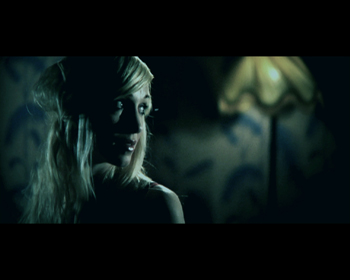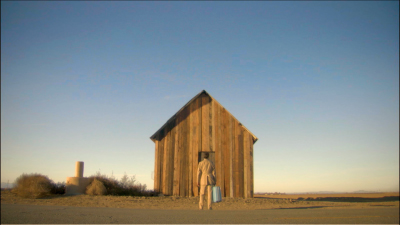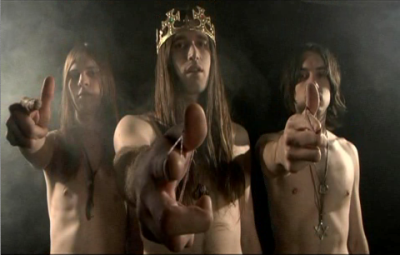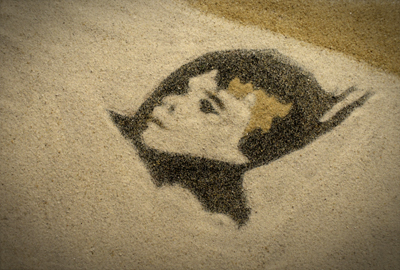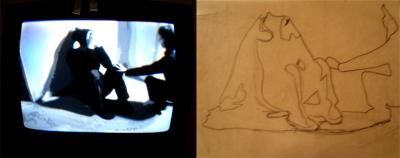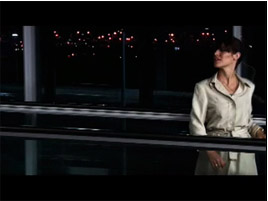A hip-hop homage to Travis Bickle that actually works? Well if you couldn't tell, we're excited...Ludacris "Slap"dir. by Philip AndelmanThe genius of Bernard Hermann's score for
Taxi Driver is the way it establishes important themes but never obscures or overpowers the images. The sounds work with and against Martin Scorsese's vision, helping create the suffocating atmosphere of the picture. There's the sultry saxophone which lures you into the seedy New York streets, while simultaneously underlining the loneliness of Travis Bickle. Then the rising drums which push forward and bang against the cacophonous trumpets as the violence crescendos. Just as the camera lingers on empty hallways and drops of rain, the score echoes the complicated inner psychosis of Bickle. Many have described Scorsese's masterpiece as a horror film, and it's Hermann's music which ads the final touch of paranoia that lingers in the hellish smoke rising from the sewers.
Ludacris picked up on the same idea in composing "Slap," using slinky west coast synths to complement the rising tension of his brooding baseline. The cheesy electric guitar is a perfect addition, evoking the excitement and fear of the night like the trumpets in Hermann's score. Yet much of this only becomes clear upon watching the visuals, in fact the song doesn't necessarily stand out amongst the other tracks on
Release Therapy. This is that rare occasion where the pictures actually make the song
much better; adding enormous depth to Ludacris's lyrics and emotion.
The director uses many of the same effects and shots as Scorsese, from slow motion drive-bys to red-hued close-ups. Direct scenes are copied - like the pull-ups in the doorway - and the narrative follows a nearly identical arc. On paper this might read like a bad idea - what's the point of so closely copying such a renowned film? Is it a cheap ploy to profit off Scorsese's art and image? Yet despite these questions, and somewhat miraculously, this video still works. Unlike the many Scarface and Godfather references you find in every other rap video, Ludacris and his director aren't using
Taxi Driver merely for its street-cred or arresting visuals. The reference actually exists as a powerful ally to the lyrics, increasing anticipation for what we think we know will happen.

The song is especially vital in this regard, as the repetition within the chorus and angry inflection of Ludacris's delivery serve to build the suspense to a fever pitch. He raps about losing a friend, being disconnected from his girlfriend and the general stagnation of his life. Then he turns his sights on the state of the world, and we can just feel the intensity of the moment as he kicks Bush and his TV onto the floor. It's a different context but since we "know" what's coming we translate the heat of Bickle's self-destruction into Ludacris's character. Yet in the next scene, based on one of the iconic moments in all of cinema, we don't get the pay off we are expecting.
One could argue this is the point where the video falls apart - without the threat of Bickle's guns, the climax might feel blasé. Ludacris stands in front of the mirror pretending to slap someone, and you almost want to laugh. That's it?
That is what you've decided to do about your pent up frustrations and excruciating loneliness? Not that slapping someone isn't a violent or physically powerful act, but Ludacris himself makes mention of a .45 earlier in the song. We almost
want him to go out in a blaze of glory.
But once again this isn't
Scarface, and Ludacris isn't playing Travis Bickle either. It'd be easy to critique the rapper's improvisations in front of the mirror when compared with De Niro's singular performance, but if you look at it on its own - which the video invites us to do with the lack of the gun - Ludacris does a fine job of channeling a different sort of spirit. In retrospect his character is far from the utterly lone soul that Bickle is. He at least
had a close friend, he has a girlfriend and what really throws him over the edge is the American government's corrupt policy and lack of respect for his community. This taxi driver is expressing more frustration than loneliness, while Bickle's frustration was a direct product of his isolation.

Ludacris isn't just frustrated with the world around him, he recognizes that part of the problem may be his own laziness. In that way he is much more like an average citizen than the mentally unstable Bickle, who never
really looks in that mirror. Granted most of us aren't walking into whorehouses and slapping around pimps, but we can relate to "I hate my 9 to 5." In
Taxi Driver the pressures of society which push Bickle over the edge are more subtle and relate more to his own inferiority complex - what screenwriter Paul Schrader called self-imposed loneliness. But here the character actually encounters death, robbery and the constant fear of war.
It isn't nearly as complex or gripping a portrait as Scorsese's magnum opus, but in its own way it relays the troubles of modern society while mirroring the themes of isolation and paranoia. It's also a monumental video for hip-hop right now. Bill O'Reilly once used this exact song as the basis of a seething
critique of the Grammys and Ludacris (who won for Rap Album of the Year), repeatedly referencing the "slapping" as proof of the rapper's promotion of violence. It was clear then and it's clear now that O'Reilly never listened to this track or gave the artist a chance. I'm certain, considering Ludacris's history with O'Reilly, that those words where in the back of his head during the shoot. For this reason alone the video must be counted as an unqualified success; a dramatic affront to anyone who fails to see the potential of hip-hop expression.
Many critics agree that Travis Bickle being hailed as a hero at the end of
Taxi Driver, after his murder spree, is a comment on the glorification of violence in American culture. So the fact that Ludacris clearly changes this major plot point in his own story is of some significance. It not only goes against the expectations set-up by the film reference, but also challenges the glorification of gun crime in
hip hop culture. This isn't a story about a drug-deal gone wrong, or a man walking in on his cheating woman (not that those stories have no relevance, but they're told all the time in this genre), it's a complex look at personal insecurity, racial issues and frustration with contemporary affairs. The rapper doesn't make himself a hero, but rather presents a story and asks us to evaluate it ourselves. Thus the ultimate irony (and glory) of Ludacris's dark Scorsese-inspired vision in "Slap," is that it may very well be
anti-violent.








